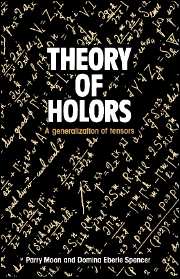3 - Gamma products
Published online by Cambridge University Press: 16 October 2009
Summary
The previous chapter has included a discussion of uncontracted and contracted holor products. These products give a fairly broad range of possibilities, though not enough to cover all physical applications. Accordingly, in this chapter we consider how increased flexibility can be obtained by use of the γ-products.
Suppose that we are dealing with a given holor but would prefer to have the indices arranged differently. This can be accomplished by multiplying the original holor by another holor γ, tailored to give the desired result.
Or one may wish to associate with the given holor a simpler holor having a lower valence. In general relativity, for instance, Einstein used the Riemann–Christoffel tensor Rijkl, a quadrivalent quantity giving considerable information about curvature of the 4-space. Contraction gives a related holor of valence 2. This holor necessarily gives less information than the original holor; but it may be adequate for some purposes and is much easier to manipulate than the original. Even greater flexibility is obtained by multiplying the original holor by γkl, whose merates can be chosen at will. Thus valence can be changed by a γ-product.
A third possibility is to obtain a related symmetric or a related antisymmetric holor by multiplying a given holor by the proper γ-holor. Thus, γ-products are useful in converting a given holor into a related holor as follows:
(a) altering positions of indices,
(b) altering valence, or
(c) obtaining a symmetric or an antisymmetric holor.
- Type
- Chapter
- Information
- Theory of HolorsA Generalization of Tensors, pp. 65 - 86Publisher: Cambridge University PressPrint publication year: 1986



